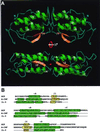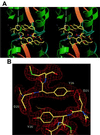Crystal structure of human stem cell factor: implication for stem cell factor receptor dimerization and activation
- PMID: 10884405
- PMCID: PMC16613
- DOI: 10.1073/pnas.97.14.7732
Crystal structure of human stem cell factor: implication for stem cell factor receptor dimerization and activation
Abstract
Stem cell factor (SCF) plays important roles in hematopoiesis and the survival, proliferation, and differentiation of mast cells, melanocytes, and germ cells. SCF mediates its biological effects by binding to and activating a receptor tyrosine kinase designated c-kit or SCF receptor. In this report we describe the 2.3-A crystal structure of the functional core of recombinant human SCF. SCF is a noncovalent homodimer composed of two slightly wedged protomers. Each SCF protomer exhibits an antiparallel four-helix bundle fold. Dimerization is mediated by extensive polar and nonpolar interactions between the two protomers with a large buried surface area. Finally, we have identified a hydrophobic crevice and a charged region at the tail of each protomer that functions as a potential receptor-binding site. On the basis of these observations, a model for SCF small middle dotc-kit complex formation and dimerization is proposed.
Figures




References
-
- Galli S J, Zsebo K M, Geissler E N. Adv Immunol. 1994;55:1–96. - PubMed
-
- Williams D E, Eisenman J, Baird A, Rauch C, Van Ness K, March C J, Park L S, Martin U, Mochizuki D Y, Boswell H S, et al. Cell. 1990;63:167–174. - PubMed
-
- Zsebo K M, Williams D A, Geissler E N, Broudy V C, Martin F H, Atkins H L, Hsu R Y, Birkett N C, Okino K H, Murdock D C, et al. Cell. 1990;63:213–224. - PubMed
-
- Huang E, Nocka K, Beier D R, Chu T Y, Buck J, Lahm H W, Wellner D, Leder P, Besmer P. Cell. 1990;63:225–233. - PubMed
-
- Lemmon M A, Schlessinger J. Trends Biochem Sci. 1994;19:459–463. - PubMed
Publication types
MeSH terms
Substances
Associated data
- Actions
LinkOut - more resources
Full Text Sources
Other Literature Sources
Molecular Biology Databases

